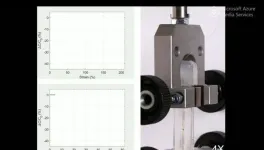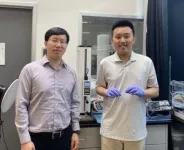(Press-News.org) Researchers at the USC Viterbi School of Engineering looked to origami to create new sensors that could someday be employed to detect deformations in organs and also for use in wearables and soft robotics.
Their paper, “High-Stretchability and Low-Hysteresis Strain Sensors Using Origami-Inspired 3D Mesostructures,” featured in Science Advances explains how USC researchers Hangbo Zhao, Xinghao Huang, Liangshu Liu, Yung Hsin Lin, Rui Feng, Yiyang Shen, and Yuanning Chang developed “stretchable strain sensors,” that can measure how much an object strains or deforms.
“The challenge,” says the paper’s corresponding author, USC Assistant Professor of Aerospace and Mechanical Engineering and Biomedical Engineering, Hangbo Zhao, “is to create sensors that can stretch significantly, respond quickly, and give precise readings even when measuring large and dynamic deformations.”
Current stretchable strain sensors mostly use soft materials like rubber—but this type of material can have irreversible changes in the material properties through repeated use, thus producing unreliable metrics related to deformation detection.
Researchers thus devised a new type of structure for the sensors. Inspired by origami, more rigid materials are folded with electrodes on each side of the panel (imagine the sensor as an upside down, opened book with two electrodes on the front and back covers). As the electrodes unfold the strength of the electrical field between the electrodes is captured. A model developed by the team then converts this reading into a measurement that captures the amplitude of the deformation.
The newly created sensors can stretch up to three times their original size with high sensing accuracy even with repeated use. In addition, the sensors respond very quickly, detecting deformations in less than 22 milliseconds in very tiny areas (approximately 5 square millimeters). In addition, they are capable of detecting strain from different directions.
Such sensors can measure large and complex deformations accurately, which can have applications in sensing motions of soft robots, tracking movements of human joints, or even monitoring organs such as the bladder to determine abnormalities that might indicate disease.
END
How origami might inform disease diagnoses
New origami-inspired sensors for soft robotics, wearables, and implantables
2023-08-25
ELSE PRESS RELEASES FROM THIS DATE:
Weight loss medication benefits patients with heart failure and obesity
2023-08-25
Amsterdam, Netherlands – 25 Aug 2023: Semaglutide improves heart failure-related symptoms and physical function and results in greater weight loss compared with placebo in patients with heart failure with preserved ejection fraction (HFpEF) and obesity, according to late breaking research presented in a Hot Line session today at ESC Congress 2023.1
Approximately half of patients with heart failure in the community have HFpEF.2 Most patients with HFpEF are overweight or obese, and growing evidence suggests that obesity and excess adiposity are not simply comorbidities, ...
Oral anticoagulation is not effective in patients with atrial high-rate episodes
2023-08-25
Amsterdam, Netherlands – 25 Aug 2023: Blood thinners (anticoagulants) cause bleeding without preventing stroke in patients with atrial high rate episodes (AHRE), but without electrocardiogram (ECG)-diagnosed atrial fibrillation, according to late breaking research presented in a Hot Line session today at ESC Congress 2023 and simultaneously published in the New England Journal of Medicine.1
Anticoagulants prevent strokes in patients with atrial fibrillation but are not effective in those without atrial fibrillation, for example in patients with ...
Colchicine fails to reduce primary outcomes in COP-AF trial but encouraging signals found
2023-08-25
Amsterdam, Netherlands – 25 Aug 2023: Colchicine does not significantly reduce perioperative atrial fibrillation (AF) or myocardial injury after non-cardiac surgery (MINS) in patients undergoing major non-cardiac thoracic surgery, according to late breaking research presented in a Hot Line session today at ESC Congress 2023.1
Perioperative AF occurs in approximately 10% of patients after major thoracic surgery, while MINS has an incidence of about 20% in the same patient population.2 Patients with perioperative AF and MINS have a poor prognosis.3,4 High levels ...
First ESC Guidelines covering all acute coronary syndromes published today
2023-08-25
Amsterdam, Netherlands – 25 Aug 2023: The European Society of Cardiology (ESC) Guidelines on acute coronary syndromes are published online today in European Heart Journal.1 The document covers the management of unstable angina and all types of acute myocardial infarction.
“Time is critical in acute coronary syndromes. When an artery supplying the heart with blood becomes blocked, the quicker we open the artery and restore flow, the less damage occurs to the heart muscle,” said Guidelines task force ...
First international guidelines on heart muscle diseases published today
2023-08-25
Amsterdam, Netherlands – 25 Aug 2023: The European Society of Cardiology (ESC) Guidelines on cardiomyopathies are published online today in European Heart Journal.1 This is the first international guideline document to include all cardiomyopathy subtypes, and the first time that specific recommendations are made for cardiomyopathies other than hypertrophic cardiomyopathy.
“This pioneering document reflects the advances in genetics and cardiac imaging and the advent of new treatments that target specific causes of disease,” said Guidelines task force chairperson Dr. Elena Arbelo of the Hospital Clinic, University of Barcelona, Spain.
“At the ...
Recommendations to reduce cardiovascular risk in patients with diabetes published today
2023-08-25
Amsterdam, Netherlands – 25 Aug 2023: Patients with type 2 diabetes are more than twice as likely to develop cardiovascular disease (CVD) than their healthy peers. Advice to lower that risk is launched today in the 2023 European Society of Cardiology (ESC) Guidelines for the management of cardiovascular disease in patients with diabetes, published in European Heart Journal.1
“Patients with type 2 diabetes have a two- to four-fold higher risk of coronary artery disease, stroke, heart failure, atrial fibrillation and peripheral artery disease compared to those without type 2 diabetes and when CVD occurs, the prognosis ...
Patients urged to be vigilant about cardiac infections
2023-08-25
Amsterdam, Netherlands – 25 Aug 2023: Patients with specific cardiac conditions such as valvular heart disease and congenital abnormalities, or those requiring a pacemaker, should practice good dental and skin hygiene to help prevent rare but potentially deadly infections of the heart’s inner lining and valves, according to European Society of Cardiology (ESC) Guidelines on infective endocarditis, published online today in European Heart Journal.1
“Infective endocarditis is an uncommon but very serious disease that can present with ...
Focused update of ESC Heart Failure Guidelines published today
2023-08-25
Amsterdam, Netherlands – 25 Aug 2023: A focused update of the European Society of Cardiology (ESC) Heart Failure Guidelines is published online today in European Heart Journal following the results of major new trials that should change the management of patients with heart failure.1
“Heart failure is a fast-moving area of research and exciting new trials are expanding the treatment options for patients,” said Guidelines task force chairperson Professor Theresa McDonagh of King’s College Hospital, London, UK. “This focused update incorporates the latest evidence-based treatments ...
Cancer drug development yesterday, today and tomorrow
2023-08-25
“One can expect that artificial intelligence (AI) will play some role in the future drug development.”
BUFFALO, NY- August 25, 2023 – A new editorial paper was published in Oncoscience (Volume 10) on August 17, 2023, entitled, “Cancer drug development yesterday, today and tomorrow.” In this new editorial, researchers Elzbieta Izbicka and Robert T. Streeper from New Frontier Labs discuss the history of cancer drug development and how it has evolved over time. The editorial also highlights the current state of cancer drug development and ...
How fast does the charge migrate in molecules?
2023-08-25
To discover how light interacts with molecules, the first step is to follow electron dynamics, which evolve at the attosecond timescale. The dynamics of this first step have been called charge migration (CM). CM plays a fundamental role in chemical reactions and biological functions associated with light–matter interaction. For years, visualizing CM at the natural timescale of electrons has been a formidable challenge in ultrafast science due to the ultrafine spatial (angstrom) and ultrafast temporal ...
LAST 30 PRESS RELEASES:
Making lighter work of calculating fluid and heat flow
Normalizing blood sugar can halve heart attack risk
Lowering blood sugar cuts heart attack risk in people with prediabetes
Study links genetic variants to risk of blinding eye disease in premature infants
Non-opioid ‘pain sponge’ therapy halts cartilage degeneration and relieves chronic pain
AI can pick up cultural values by mimicking how kids learn
China’s ecological redlines offer fast track to 30 x 30 global conservation goal
Invisible indoor threats: emerging household contaminants and their growing risks to human health
Adding antibody treatment to chemo boosts outcomes for children with rare cancer
Germline pathogenic variants among women without a history of breast cancer
Tanning beds triple melanoma risk, potentially causing broad DNA damage
Unique bond identified as key to viral infection speed
Indoor tanning makes youthful skin much older on a genetic level
Mouse model sheds new light on the causes and potential solutions to human GI problems linked to muscular dystrophy
The Journal of Nuclear Medicine ahead-of-print tip sheet: December 12, 2025
Smarter tools for peering into the microscopic world
Applications open for funding to conduct research in the Kinsey Institute archives
Global measure underestimates the severity of food insecurity
Child survivors of critical illness are missing out on timely follow up care
Risk-based vs annual breast cancer screening / the WISDOM randomized clinical trial
University of Toronto launches Electric Vehicle Innovation Ontario to accelerate advanced EV technologies and build Canada’s innovation advantage
Early relapse predicts poor outcomes in aggressive blood cancer
American College of Lifestyle Medicine applauds two CMS models aligned with lifestyle medicine practice and reimbursement
Clinical trial finds cannabis use not a barrier to quitting nicotine vaping
Supplemental nutrition assistance program policies and food insecurity
Switching immune cells to “night mode” could limit damage after a heart attack, study suggests
URI-based Global RIghts Project report spotlights continued troubling trends in worldwide inhumane treatment
Neutrophils are less aggressive at night, explaining why nighttime heart attacks cause less damage than daytime events
Menopausal hormone therapy may not pose breast cancer risk for women with BRCA mutations
Mobile health tool may improve quality of life for adolescent and young adult breast cancer survivors
[Press-News.org] How origami might inform disease diagnosesNew origami-inspired sensors for soft robotics, wearables, and implantables




